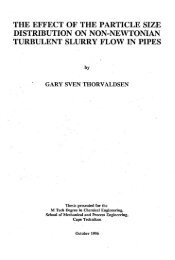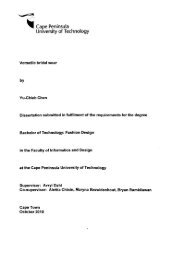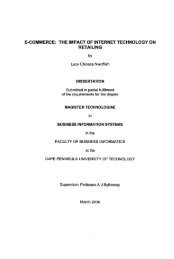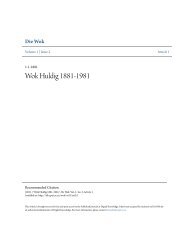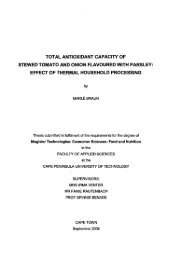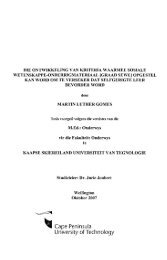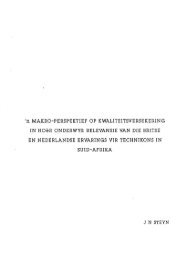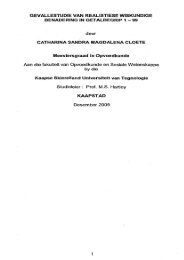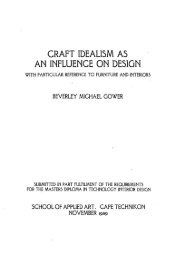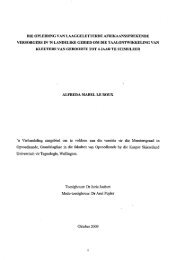an investigative analysis of the psychological characteristics and job ...
an investigative analysis of the psychological characteristics and job ...
an investigative analysis of the psychological characteristics and job ...
Create successful ePaper yourself
Turn your PDF publications into a flip-book with our unique Google optimized e-Paper software.
Robbins <strong>an</strong>d Hunsaker (1989:34-35) agree with <strong>the</strong> above <strong>an</strong>d state that listening is making sense<br />
out <strong>of</strong> what is heard. That is, listening requires paying attention, interpreting <strong>an</strong>d remembering<br />
sound stimuli. They conclude that active listening requires aperson to empathise with <strong>the</strong> speaker<br />
so that he c<strong>an</strong> underst<strong>an</strong>d <strong>the</strong> communication from his point <strong>of</strong> view. There are four essential<br />
requirements for active listening. Aperson needs to listen with intensity, empathy, accept<strong>an</strong>ce <strong>an</strong>d<br />
awillingness to take a responsibility for completeness.<br />
Rue <strong>an</strong>d Byars (1993: 57); Nelson-Jones (1986:135, 163) <strong>an</strong>d leMon (2000:93) elaborate on <strong>the</strong><br />
above by defining listening as <strong>the</strong> primary method <strong>of</strong> receiving messages. It is a powerful way <strong>of</strong><br />
afliOlling <strong>an</strong>o<strong>the</strong>r hum<strong>an</strong> being. Effective listening requires aperson to be able to respond helpfully<br />
<strong>an</strong>d it signals respect<br />
The ability to listen is a characteristic that <strong>the</strong> CEl uses in his daily communications with all <strong>the</strong><br />
role players in <strong>the</strong> co-operative education environment He must be able to listen effectively to<br />
respond correctly to <strong>the</strong> relev<strong>an</strong>t communication.<br />
2.4.24 Ability to Make Decisions<br />
What happens in making adecision? Stone (1991 :43) <strong>an</strong>swers this question by stating that <strong>the</strong> fact<br />
that a decision has to be made must be discerned, <strong>an</strong>d that criteria for choice must be set out<br />
Facts <strong>an</strong>d opinions must be obtained <strong>an</strong>d <strong>an</strong>alysed, alternatives must be set forth, <strong>the</strong> utility <strong>of</strong><br />
each alternative must be calculated, outcomes <strong>an</strong>d side-effects <strong>of</strong> each course <strong>of</strong> action must be<br />
forecast <strong>the</strong> action must be selected, implemented <strong>an</strong>d monitored.<br />
Newm<strong>an</strong> <strong>an</strong>d Hodgetts (1998:124-126) agree with <strong>the</strong> above. They conclude that decision-making<br />
begins with a definition <strong>of</strong> <strong>the</strong> problem. The next step is to ga<strong>the</strong>r data about <strong>the</strong> problem. From <strong>the</strong><br />
infoOllation that is ga<strong>the</strong>red, alternative solutions to <strong>the</strong> problem need to be formulated. Now a<br />
decision has to be made regarding which <strong>of</strong> <strong>the</strong>se alternatives will best solve <strong>the</strong> problem. The next<br />
step is to choose <strong>the</strong> best aI1emative. Once <strong>the</strong> best alternative has been chosen, it is import<strong>an</strong>t to<br />
<strong>an</strong>alyse <strong>the</strong> consequences <strong>of</strong> <strong>the</strong> decision. Based on all <strong>the</strong> <strong>an</strong>alysis, <strong>the</strong> decision should now be<br />
put into action.<br />
63



